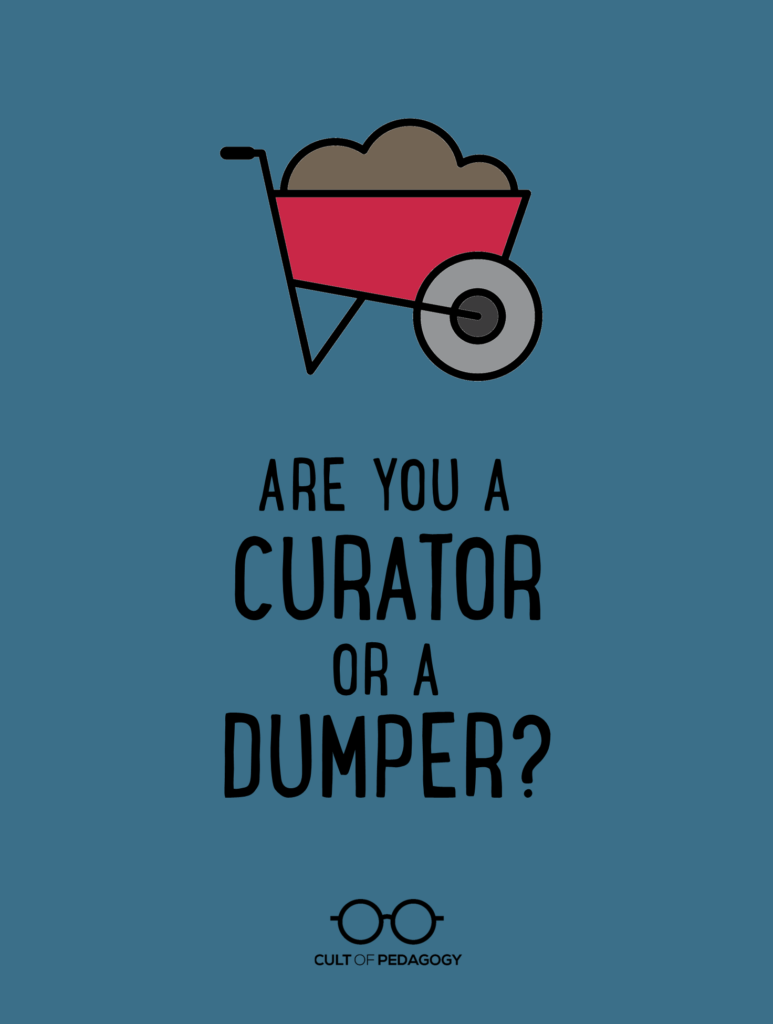
Listen to this post as a podcast:
Sponsored by Peergrade and Pear Deck
Suppose you know a lot about a certain topic. For the sake of argument, let’s say that topic is sushi.
One evening you’re on social media somewhere and an acquaintance posts this: “Have never tried sushi. Any advice?”
Oh my gosh! You totally have advice!
You start by sending your friend a link. Then you find another one. Then, well…there’s just so much great stuff out there! She should know about it. So you send her over to this Google Doc you made that contains more links:
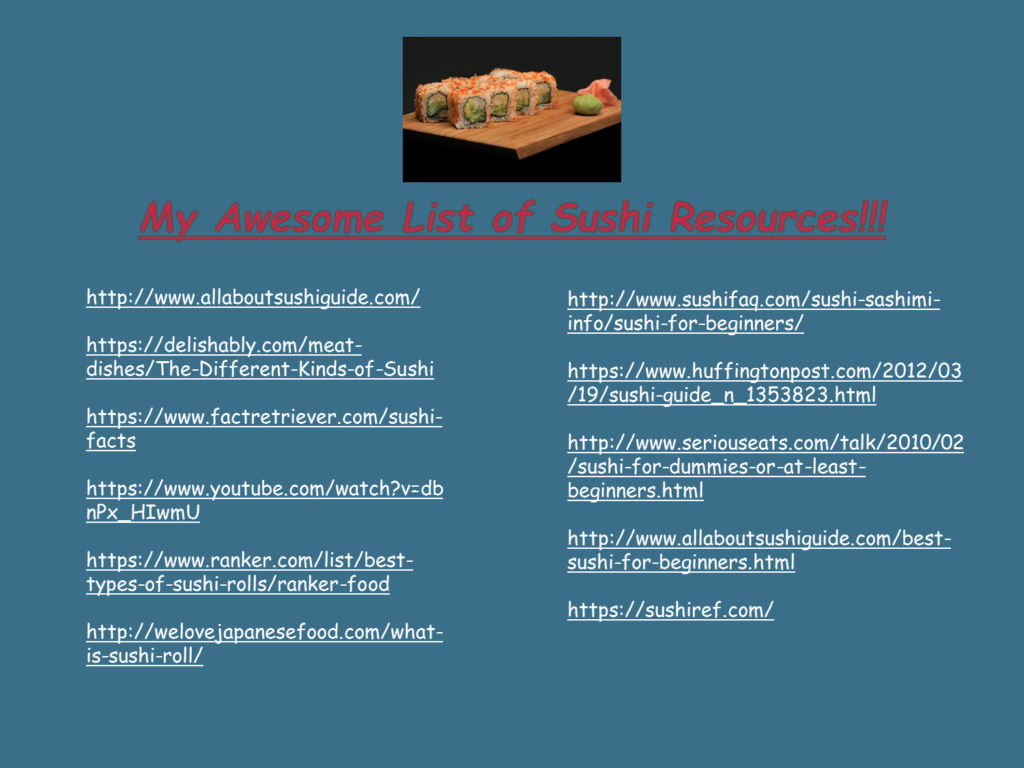
I hate to break it to you, but your friend? She went to that first link you sent and read most of the article. It gave her some useful information—stuff she probably could have looked up on her own, but still. It helped. The second link she meant to get to, but she got called away from her computer and never got back to it. And your Google Doc? She took one look at it, got overwhelmed, and left.
And it’s a shame, because you have some really good stuff on that list. Especially the one in the right-hand column, second to last on the list. This one. It’s funny. And practical. It’s like a real person helping the reader find a way to add sushi to her life.
But your friend never read that one, because there was no way to sift it out from the others, no way to know what made it special, and like everyone else, your friend only has so many hours in the day.
You just dumped too much on her at once. You were being a dumper.
And it’s unfortunate, because you have vast experience with sushi. You really are the ideal person to hand-select a few resources that would perfectly meet her needs. Imagine if you had looked over your list and picked out a smaller number of items, then shared them in a way that would preview each one before she even opened it.
Something like this:
If you’d sent this to her, you would have been curating, not dumping.
I have written about curation before, but last time, I was talking about curation as a class assignment, something students do. Now I want to focus on you, the educator. Whether you’re a teacher, an administrator, a librarian, a researcher—whatever you do, chances are you have information to share with other people, and developing your curation skills—both in terms of how much you offer and how you deliver it—is going make that sharing a lot more effective.
So let’s take a look at how the brain responds to dumping, some school-related situations when good curation skills would come in handy, a set of curation guidelines to follow, and a short list of tech tools that can help you curate digitally.
Why Dumping is Bad for Brains
When we dump a lot of information on a person at once, we are working against their brain. Cognitive load theory suggests that the brain can only take in so much at once. When we’re presented with a whole bunch of information, our brains have to ignore some in order to process the rest. Eventually, if too much keeps coming at us, we reach the point of cognitive overload, where we get more than we can handle. At that point, a lot of people just shut down, and even simple information can’t get in.
It’s a bit like this photo. Imagine being told to go learn something about history from the objects in this room.

“bric-a-brac” by Kevin Utting is licensed CC BY 2.0
No doubt, there are plenty of items in the room that have historical significance, but they’re all just dumped in there. Our brains learn by grouping lots of pieces of information into groups and patterns—cognitive scientists call these patterns schemas—and connecting it to knowledge we already have in long-term memory. Someone with considerable knowledge of the time periods represented in that room would be able to make some sense of it.
But the rest of us would do better off with the help of curators. That’s what a good museum does for us: It takes piles and piles of artifacts and selects only a few to represent an idea, a moment, an event, or a phenomenon. Then it carefully arranges those artifacts, starting with an introduction, often something written by the curators themselves to introduce the collection and provide us with meaningful context.
Then it introduces the artifacts in groups—again, adding its own editorial comments and explanations along the way, guiding us through the experience so that we aren’t forced to take too much in at once. We’re given time and space to savor each artifact one at a time.
Instead of being crowded into one big heap, items are grouped together under a common theme, so we see them as parts of a larger whole.
It’s not only museums that pay attention to this stuff. The tech industry is also very concerned with cognitive overload. In fact, there’s a whole field in tech called user experience design (UX for short). UX designers spend all of their time looking at how to improve the way users interact with websites and other digital products. They look at the smallest details, like the shape of the buttons we click, whether serif or sans-serif fonts get better responses, and where exactly to place a menu on a page. This article from Smashing Magazine does a deep dive into the topic, if you want to read more. Companies that invest in UX know that if they don’t bother with these details, you will eventually leave and go to another, better designed site. Even though educators don’t have the financial incentive to pay attention to this stuff, we should. Plenty of situations would give us better results if we did.
Sample Scenarios
Here are a few education-related scenarios where good curation could make a difference:
- Student-Directed Learning: As more classrooms move toward differentiated, flipped, blended, and student-directed learning models, we will need to do more gathering and sharing collections of resources for students to choose from, rather than picking one resource to deliver to everyone at one time. If our delivery is sloppy or our collections are thrown together kitchen-sink style, these models will be less successful. One of the most popular HyperDoc models includes an “explore” section, where a set of resources is provided and students choose which items to engage with in order to learn about the topic. Too many choices just dumped together will overwhelm most students. So offer choice, yes, but curate those choices carefully so students don’t waste a lot of time wading through all of their options.
- Classroom or school libraries: If students aren’t checking out books very often, you may be able to improve things with more curation. This may come in the form of aggressively weeding out books that students have no interest in, a process teacher Pernille Ripp described as an essential step toward building a thriving classroom library. It might also include creating special displays of books grouped around a common theme, or posting student recommendations on specific books like they do with staff recommendations in bookstores.
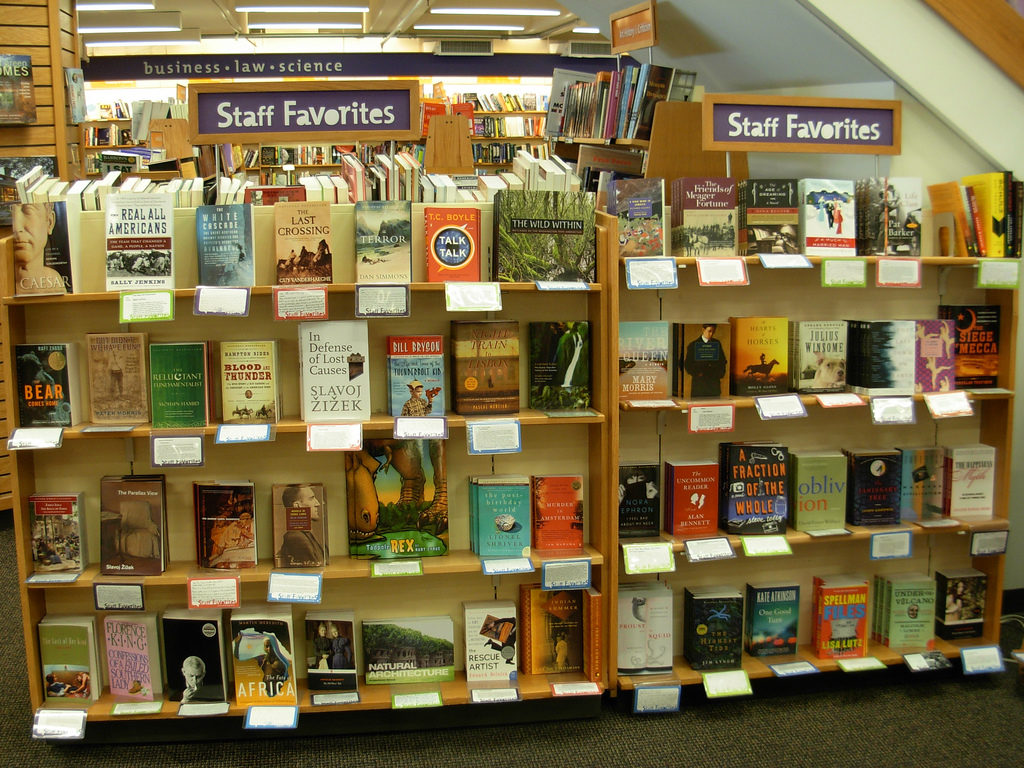
“Staff Favourites – University of Washington bookstore” by brewbooks is licensed under CC BY-SA 2.0
- Communication with Parents: When we send newsletters, flyers, and emails home to parents, we obviously want them to be read. But as a mother of three, I can tell you that an awful lot of skimming is happening. With that in mind, we will have much greater success if we apply some basic curation and design principles to those items. I wrote about this in a guest post for Laura Candler’s Teaching Resources (formerly, Corkboard Connections) a few years ago: Why No One Reads Your Classroom Newsletter.
- School or Teacher Websites: It seems that one company designed the basic template for all school and district websites around maybe 2004, and since then, far too many schools have never strayed from that. I’m not going to point fingers at any one school, but I think you know what I mean: The menu has hundreds of items, the page is broken up into dozens of little squares of information, and everything is in 12-point font. No white space. They are functional, yes, but cluttered. By contrast, take a look at the websites of The Dalton School, in New York City, Vail Mountain School in Vail, Colorado, or the Gibraltar School District in Woodhaven, Michigan. These sites make me want to click around, learn more. They make me excited about the learning that is happening in these schools. And it all comes down to the design, the thoughtful way the content is organized with the user experience in mind.
- Sharing Research: Maybe you’re trying to convince your team to try a new method. Maybe you’re an administrator who wants your staff to learn more about a certain learning theory. Maybe you’re delivering PD to a group of teachers. Or maybe you are the one doing the research and you want to get it out to the world. In any of these situations, taking the time to narrow your focus to just a few items, then share them in a way that’s appealing will make it more likely that people will actually consume the stuff you’re sharing. For in-person delivery, getting better at slide design and presentation can help a lot; for that, I recommend Garr Reynolds’ book, Presentation Zen. For online sharing, check out The Learning Scientists and RetrievalPractice.org—both are excellent examples of taking complex research and making it consumable for a wider audience.
Curation Guidelines
In any of the above scenarios, keep the following guidelines in mind when deciding what to share and how to share it.
1. Keep the Best, Lose the Rest
Less is almost always more, so once you get to the point where you’re sharing multiple resources on the same topic, you should be able to get rid of some and keep only the very best. This is easier said than done, because you want to be helpful and every additional item probably does add something unique to the mix. Just keep reminding yourself that the goal is to have the person actually consume the thing you’re sharing, and too much will send them running for the hills, so keep paring it down until it’s a nice, manageable size.
2. Chunk It
If you are sharing more than just a few resources, break the collection into smaller sub-sets. Give each section some kind of title to help users find what they are interested in more quickly.
3. Add Your Own Introductions
Just like museum curators place an explanatory paragraph near most artifacts, you can do the same with your resources. Give your audience some context to help them know what the resource is and what they will learn from it. Another way to do this is to offer a brief preview or excerpt from the article itself.
4. Use Images as Anchors
Although this can take extra time, adding an image before each item, like I’ve done below for the list of tools, can help readers visually distinguish one item from another. It will also help them find items more quickly later on.
5. Polish your Hyperlinks
When your resource sharing includes a link to something, you can provide that link in one of two ways. Giving the person the raw “http” link will certainly work, but these links usually look cluttered and complicated. What’s more appealing to the human eye is text that tells us something about the thing they’re clicking over to. You can accomplish this by changing the link text.
So instead of saying here, watch this: https://www.ted.com/talks/susan_david_the_gift_and_power_of_emotional_courage
You could say here, watch this TED Talk about Emotional Courage.
Every program does this a little bit differently, but once you’ve learned how to do it in one place, you should be able to figure it out in other places. To get you started, here’s a quick tutorial for how to insert a link in a Google Doc.
6. Always, Always Build in White Space
I can’t emphasize this one enough. Creating space around your resources is essential for a good user experience. So whether you’re sending an email, creating a newsletter, or designing a bulletin board, avoid cramming items together. Instead, cut back on the number of items and give your audience’s eyes some rest.
Curation Tools
For times when you’re curating digitally, these tools can help:
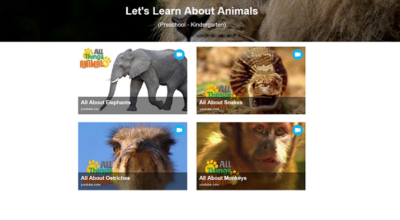
elink
elink.io
This is probably the simplest of all: Just insert a link and the tool lets you add your own introduction paragraph and image. This is the one I used for the sushi example at the beginning of this post.
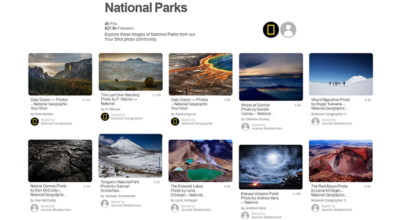
Pinterest
pinterest.com
Save links to resources on themed boards, then share those boards with others.
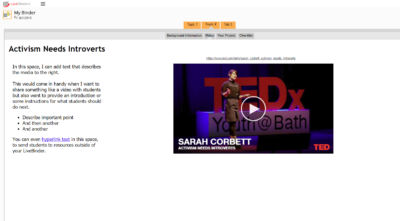
LiveBinders
livebinders.com
A LiveBinder is like an online notebook, where you can organize collected items under individual tabs. In a single LiveBinder, you can gather links to websites, videos, uploaded documents, and personal notes you type in yourself, making this an excellent tool for larger, more complex collections.
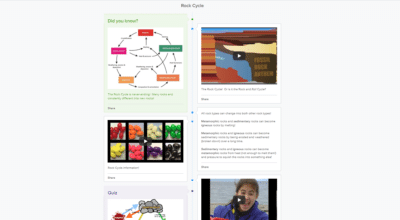
Sutori
sutori.com
Collections on this platform are organized as vertical timelines. This is an especially nice option if you want your audience to experience your collection in a specific order, almost in the same way that a museum creates a “path” for visitors.
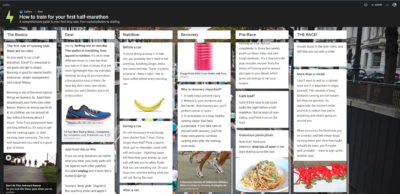
Padlet
padlet.com
This virtual corkboard offers a nice space for posting notes, images, and links to online articles and videos. Because it has good features for collaboration, this is a nice option for curating a collection with other people.
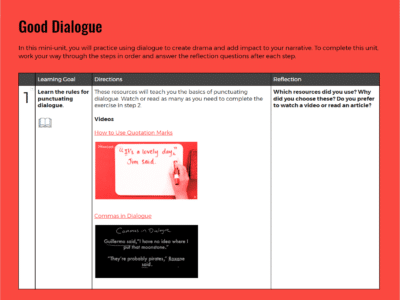
HyperDocs
A HyperDoc is not a specific website or app: You make these yourself out of a Google Doc. The HyperDoc framework would be perfect for building and sharing collections of resources. Learn more about HyperDocs here.
Why Bother?
So what’s the point of all this? We’re not running a museum. We’re not designers. Our job isn’t necessarily to entertain and enthrall our students with graphic design and finely tuned UX. So why bother?
Apart from the fact that it just makes things work better, developing our curation skills is just another way to elevate our craft. We have machines to provide information, to dump it all in a pile in front of us. What really smart, intuitive humans can do for each other—as teachers, as colleagues, as administrators—is curate. If we aspire to call ourselves master teachers, we also should be clear on what that actually means. The essence of our work is taking vast swaths of information and helping our students make sense of it. As college instructor Norman Eng says, “Think of yourself less as a teacher and more as a designer of meaningful experiences.” We’re going to share the information anyway; we might as well do it with style. ♦
Join my mailing list and get weekly tips, tools, and inspiration—in quick, bite-sized packages—all geared toward making your teaching more effective and fun. You’ll get access to our members-only library of free downloads, including 20 Ways to Cut Your Grading Time in Half, the e-booklet that has helped thousands of teachers save time on grading. Over 50,000 other teachers have already joined—come on in!

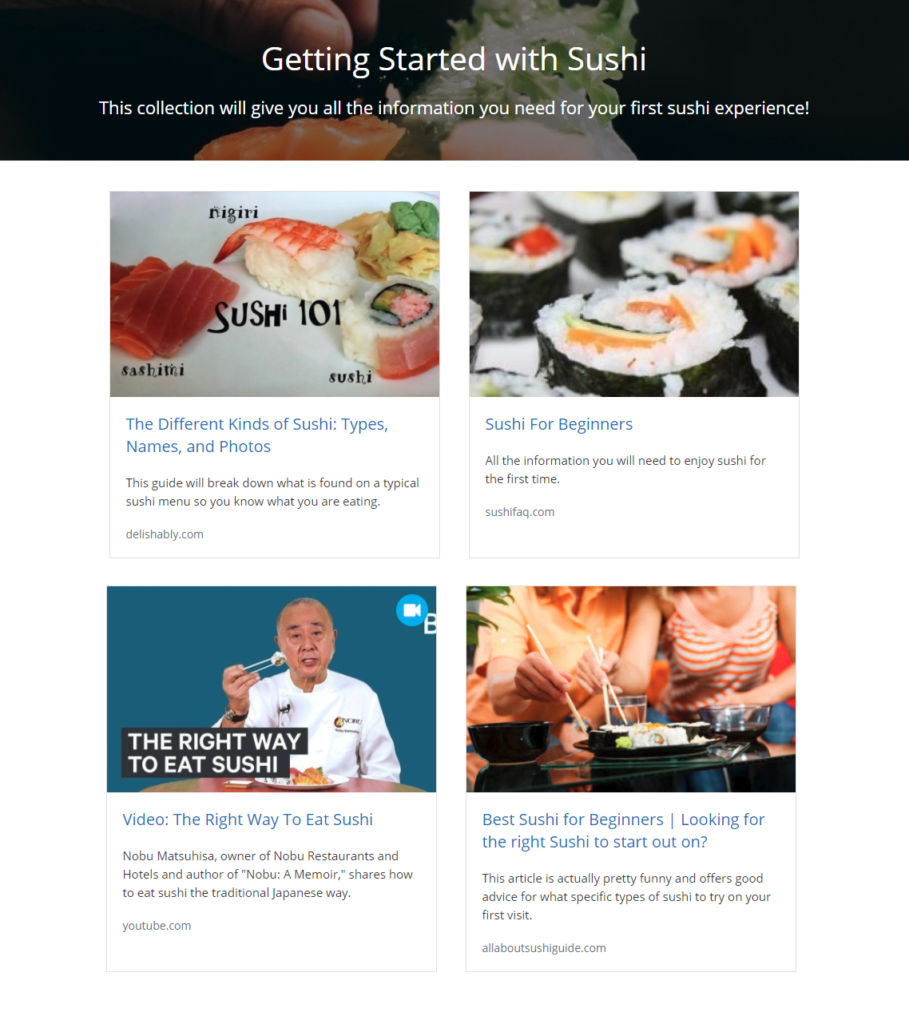
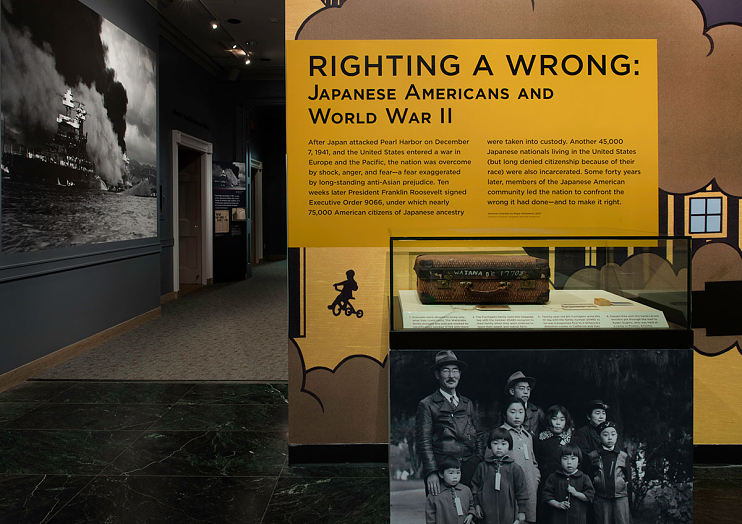


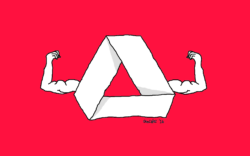
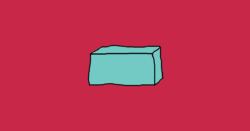
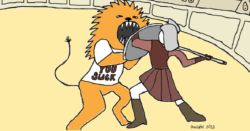
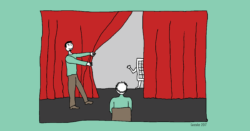
All of the excellent points you make also apply to graphic design. Good graphic design delivers visual and textual content that is audience-aware, well curated, delivered in chunks, with sensivity to white space, and thoughtfully paced — all to avoid information dumping. That’s what is all about.
I just wanted to share a Curator who I follow often. Hope you enjoy! He does a “BrainBlast” weekly with all other items. Even some jokes.
http://www.todd-finley.com
Todd Finley is one of the best curators out there. His Twitter feed is a great resource to me. Of course, Jenn Gonzalez is another great curator. She cuts through the clutter, as shown in this post!
finleyt@ecu.edu
Thank you for your kind words, Angela and Elizabeth. Unfortunately, I’m the poster-child for dumping! Jennifer G. has a fantastic design sense and an uncompromising aesthetic. I’m in awe of her work!
Thank you for this very timely reminder, there is just so much “stuff” out there in education today. I went to a presentation by Brian Cambourne a number of years ago, and he used a similar theme, and similar images of horders. It was very powerful as is your reminder. I often send teachers I coach articles and strategies, but I do sift through them first. I guess I am guilty at times of dumping. I love the suggestions you have, the sushi example is perfect. And the idea of white space. I am preparing for a workshop tomorrow and this morning decided to keep the resources I share to a minimum. Then I read your post and feel comfortable with my decision. Thank you again for your sharing.
I am also guilty of dumping…I need to work more on using my technology resources rather then doing everything the “old school” way.
Such an important post. Makes me think about how many times I’ve seen this: on parents at Back to School Nights giving them way too much info and jargon; on teachers at tech PD showing 32 great tech tools that must be used now; on staff showing all the data from the last round of testing…Everyone, settle down! No one can get a drink from a fire hydrant.
Wake up call and solid advice on how to curate a collection of ideas rather than throw everything into a bin. I’m going to weed and re-organize my collection of links using Padlet. Thanks!
I got a lot of good information I can use out of this issue. Don’t get me wrong- I love all your podcasts, but this just came at the right time. Thanks!
Excited to ready this piece Jennifer. Most of my work with teachers involves curation, pretty jazzed about it based on what I have observed. Thought I would share:
When you think of a museum curation it is a specific and strategic collection of pieces that convey a message, feeling or idea–the curation can transform the individual pieces.
In my course, students submit a Learning Curation. I wanted this to be a curation instead of a journal or collection to encourage metacognition and transformative learning that is notoriously difficult to corral in our individual inquiries. The Learning Curation requires responding to readings via learning curation prompts but also including anything else students wish, crafted through their interests, choices and their essential question/inquiry. This then becomes a curation because they have a collection of things but they are uniquely shaped, by students into something new via their inquiry. Collection + Transformation = Curation
Yet another timely post from Cult of Pedagogy! I am in the process of cleaning up my “dump” of a MOODLE page for one of my classes and was able to delete 7 page links and replace them with a single Padlet containing only the pertinent readings, and with enticing images to boot.
Thanks again!
This is a good sharing. It is good to know how curate makes things organized and accessible to students. Indeed, we have so many things to share with them and often we ‘shared’ too many things at the same time. So, this sharing has opened up an idea for me.Thanks!
Hi Jennifer!
Great post! Have you tried Scoop.it as a curation tool! Super easy to use, visibily appealing and an easy part of your workflow.
Thanks for sharing!
John
The Smithsonian Learning Lab is a great tool for curation. You can browse thematic collections of resources made by other teachers and Smithsonian staff, and create your own. You can also have students curate collections. https://learninglab.si.edu/
Hello!
The American Association of School Librarians (AASL) released a new set of national standards in November. They include six shared foundations and key commitments; they are: Inquire, Include, Collaborate, CURATE, Explore, and Engage. The extended description for Curate is: “Make meaning for oneself and others by collecting, organizing, and sharing resources of personal relevance.” As a high school librarian, it is critical that students know how to curate resources. We teach them to do this through the effective use of domain specific vocabulary, critical evaluation of resources and the careful selection of information. No easy task for sure!
Thank you for many helpful links! As a reading specialist I know I can be guilty of “dumping” on teachers when I get excited about helping them with a topic for which they are seeking assistance. This post will help me be more mindful in my communications, not only of the teachers with whom I collaborate but also the parents of the children I teach.
Hi Jennifer,
Great podcast! I am definitely guilty of going down a rabbit whole when researching a topic and sometimes overwhelm myself! This article gave me a lot to think about. Thank you!
I do have 1 suggestion. Is there a way you can make your links open in a new tab? I was listening to and reading your podcast at the same time. When I saw links that I wanted to visit and clicked on them, they didn’t open in a new tab. This meant I had to go back to your podcast page and hit play again and estimate how much to fast forward. This may be just my issue, but sharing just in case it’s an easy fix.
Michi
Hi Michi,
Great question! I work with Cult of Pedagogy — one thing you can do is right-click on any link, and you’ll have the option to open it in a new tab or new window. This will apply for any website. Jenn used to have links open up in new tabs, but her developer said that more websites are moving toward opening in the same window and letting the user make the decision for themselves.
Miche –
Check your browser settings to see if you can automatically open links in a new window. Also, when making hyperlinks in the text written in Google.docs (and many other applications), you can check a box choose to have links open in a new window.
Thanks so much for sharing this! I teach United States History and feel guilty frequently about the amount of content I have to leave out. Sometimes, this internal pressure gets to me and I “dump” info on students in poorly designed lectures or collections of sources in attempt to “cover” more. My best lessons, however, involve a small collection of documents selected to help students answer a focused question. Thinking of these lessons as “museum exhibits” will help me fight that internal pressure to teach it all.
Yes, I feel that pressure too! I think it’s common among teachers. I called my strategy for dealing with it “educational triage,” but I think “curation” sounds much more scholarly!
What a great post! Thank you! I’ve added it to the resources on my wikipage on curation and curation tools!
http://webtools4u2use.wikispaces.com/Curation+Tools
You referenced some amazing district websites in your article. Any chance you know about WCAG 2.0? I know some districts that are worried about adhering to accessibility laws. Trying to brainstorm & get to the bottom of what they actually need to do/worry about.
Hi Kirt,
I work with Cult of Pedagogy – thanks for raising this issue. We’re hoping someone else who knows about WCAG 2.0 can help us out here, and share what they know.
As a researcher, author, and eager consultant to dozens of teachers each month, I have really had to tame my “dumper” tendencies. Careful curation is a must. I am reminded by this post that I need to help teachers curate for their students. Thanks, Jenn, as always. You never fail to clarify something for me – to bring it to the surface.
This was a great way to start my week! Our team works together to plan and often times we “dump” our ideas in one place hoping to find time to go back and cull through the materials.
I especially appreciate the timeliness of this article because I teach a 5/6 combo class and I am trying to keep it all sorted and separated for grade specific items. I am looking forward to checking out the links and other ideas! And I love the reminder that it is okay to not to use everything that is passed on…sometimes we worry about offending others by not using their ideas and this is a reminder that it is okay.
Thanks!
Very interesting post. As the curator I attempt to be , I hope student voice , peer reviews and this post will let me be more qualified . I would suggest https://www.pearltrees.com & https://sqworl.com to add to the list of awesome tools as well as others in this board : https://spotlight.edmodo.com/product/bookmarking-curation-resources–393581/.
So much great info here! My go-to curating tool is Bag the Web.
This was so good! Hi, my name is Lynn and I’m a dumper! LOL
In the past year or so I’ve been exploring the concept of minimalism in my home but I’d never found a way to think about the concept with my resources (both digital and what I share with people)…until now! This idea you’re sharing Jenn is like minimalism for ideas! Yes! Thanks for being awesome, as always!
Great post, thanks for sharing!
There are times when I felt I was curating for my students but I was actually dumping. From here on, minimalism with captions, short videos, and visuals will be my mantra.
Thanks for bringing clarity to this approach. This is exactly what I’ve been enjoying-listening to these podcasts and reading teacher responses.
Another great podcast on curation. I will be sharing links to both during a district presentation, Curation in the Classroom, in a few weeks. Thank you for the inspiration.
Thank you, I am learning a lot from your podcasts and am using that learning in my graduate school classes.
So glad to hear this, Linda — I’ll make sure Jenn see this!
Hi Jenn,
Your article has been very helpful, it has helped me to analyze my online learning activities that I have presented to my students in previous years. Thanks for the new tools I am thinking of using: sutori or padlet.
Hey!
Thanks for the positive feedback! I’ll be sure to share this with Jenn.
Thanks for the thoughtful information. I suddenly am seeing what my students must be experiencing as my school has asked me to look at a lot of information about how to shift to an online platform. None of us were hired to teach this way, and I applaud their efforts to point us to meaningful resources. This is a lot of information and a great deal of adjustment to do in a very short time. What normally might not feel like “dumping” can be a bit overwhelming. Quite the lesson as I find myself in the shoes of my students.
Thank you for sharing, this is great….
I learned so many things, really appreciate it so much.
I am definitely a dumper. I often feel like I give parents too much information during attendance meetings. Trying to find the root of why a student is truant is sometimes challenging due to several barriers within the family and student. I need to to work on getting more background information prior to my meetings so that I can come with more relevant resources.
Thanks for this topic: are we curator or dumper? I learned so much because I am still very traditional in my instruction.The challenge for me really is to make my presentation better (as to elevate my craft). I like very much what you have said: “Think of yourself less as a teacher and more as a designer of meaningful experiences”
I find it hard not to be a dumper, because I want to give all the information I can. I see how it could be overwhelming. Being a curator will take some practice and knowledge of resources.
I find it hard not to be a dumper. I try to give all the information I have. I see how it can be overwhelming to a student. Being a curator will take some practice and knowledge of resources.
There is so much to learn on this page about curation on this page. It was captivated from the beginning to the end. I also love the fact that you embed your audio with the transcript and will love to hear from you in the nearest future. Thank you!
Many thanks,…I have learned the value of being an intentional curator to avoid students experiencing cognitive overload.
Hanaa El-Ansary
Preschool Director
Irvine, CA
Thank you for the information. I have utilized some concepts of curation, but I could definitely tweet it here and there. I think refreshing what I know with your information will help make this year better.
I feel like I am a mixture of both. When it comes to newsletters I feel that I am a dumper. On my personal website it is more curated.
Thanks so much for this podcast. With the school year just beginning, the suggestions here will be very helpful as I share information with my students.
As a Special Education Teacher I am normally careful about how much information I give to students at one time so as not to overload them; but I really like the idea of sharing information using picture headings. That will really grab their attention and help them remember where to find the information they are looking for in the posting. It is very easy to dump using google classroom. We have to be much more aware of how we post so that students don’t get overwhelmed. I agree.
Interesting. Validates what I have been doing for 20 + years as a college and high school instructor.
Thank you so much for your valuable inputs. I felt that I was a curator so far, because as a teacher we tend to collect and keep everything. But actually, after your podcast, I feel more like a dumper…
Now, my motto is change !
I loved the museum curator example. Perfect analogy and way to look at a concrete example of what curating online is
I love this post! I have found Google Classroom posting has hone my skills for delivering student content and incorporating links for them, but I am about to share some of my lessons learned with colleagues next week and was wondering how to condense all my ideas and examples about collaboration approaches during our PD session. I love the idea of providing one line introductions and embedded hyperlinks with snapshot images for each source / example I want to share, then briefly taking them on a tour of each one in turn.
I have been using Google Sites as digital binders for each student to organize their class work each day, so this example would be a great way to help them summarize their learning too.
Thanks for sharing.